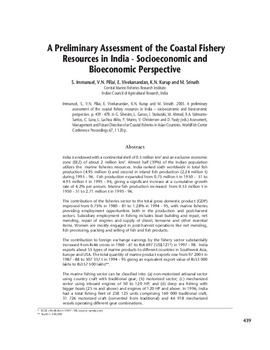A preliminary assessment of the coastal fishery resources in India: socioeconomic and bioeconomic perspective

Citation
Immanuel, S. et al. (2003). A preliminary assessment of the coastal fishery resources in India: socioeconomic and bioeconomic perspective. p. 439-478. Assessment, management and future directions for coastal fisheries in Asian countries. WorldFish Center conference proceedings; 67
India is endowed with a continental shelf of 0.5 million km2 and an exclusive economic zone (EEZ) of about 2 million km2. Almost half (39%) of the Indian population utilizes the marine fisheries resources. India ranked sixth worldwide in total fish production (4.95 million t) and second in inland fish production (2.24 million t) during 1995 - 96. Fish production expanded from 0.75 million t in 1950 - 51 to 4.95 million t in 1995 - 96, giving a significant increase at a cumulative growth rate of 4.2% per annum. Marine fish production increased from 0.53 million t in 1950 - 51 to 2.71 million t in 1995 - 96. The contribution of the fisheries sector to the total gross domestic product (GDP) improved from 0.75% in 1980 - 81 to 1.28% in 1994 - 95, with marine fisheries providing employment opportunities both in the production and post-harvest sectors. Subsidiary employment in fishing includes boat building and repair, net mending, repair of engines and supply of diesel, kerosene and other essential items. Women are mostly engaged in post-harvest operations like net mending, fish processing, packing and selling of fish and fish products. The contribution to foreign exchange earnings by the fishery sector substantially increased from Rs46 crores in 1960 - 61 to Rs4 697 (US$121*) in 1997 - 98. India exports about 55 types of marine products to different countries in Southwest Asia, Europe and USA. The total quantity of marine product exports rose from 97 200 t in 1987 - 88 to 307 337 t in 1994 - 95 giving an equivalent export value of Rs53 000 lakhs to Rs357 500 lakhs**. The marine fishing sector can be classified into: (a) non-motorized artisanal sector using country craft with traditional gear; (b) motorized sector; (c) mechanized sector using inboard engines of 50 to 120 HP; and (d) deep sea fishing with bigger boats (25 m and above) and engines of 120 HP and above. In 1996, India had a total fishing fleet of 238 125 units comprising 160 000 traditional craft, 31 726 motorized craft (converted from traditional) and 46 918 mechanized vessels operating different gear combinations. For artisanal fishing, the use of canoe and boat seine in Kerala provided the highest net income of Rs0.10 lakh with an annual catch of 51 t and an initial investment of Rs0.85 lakh. In motorized fishing, canoe and ring seine in Kerala offered a net income of Rs0.98 lakh with an annual catch of 220 t and an initial investment of Rs5.0 lakh. All major fishing units in Kerala, Tamil Nadu and Gujarat have higher profits not because of higher levels of fish catch but due to a better fish price. In the motorized sector, the increase in the price of fish over the years is greater than the increase in fuel expenditure. Small trawlers, purse seiners, dol-netters, gillnetters, pair trawlers and sona boats are the major types of mechanized fishing units operating in the inshore waters (up to 50 m depth). Trawlers and gillnetters are mostly operated along the Indian coasts whereas the fishing fleet mentioned above is confined to certain regions only. A small trawler (32’ - 36’) has a net income of Rs0.90 lakh with an annual catch of 72 t and initial investment of Rs5.2 lakh in Karnataka. A purse seiner has a net earning of Rs3.14 lakh per year with an annual catch of 280 t and an average investment of Rs10 lakh. However the average value of fish caught in a purse seiner is Rs4.29 per kg set against the break-even cost of Rs3.16 per kg. To assess the economic sustainability of Indian marine fisheries in the period 1985 to 1998, the surplus production model or Schaefer Model was applied. Based on this, the maximum sustainable yield (MSY) was estimated at 2 353 726 t with an estimated effort of 984 586 annual fishing hours (AFH). Using the Fox surplus production model, MSY was equal to 2 973 752 t with an effort of 6 126 232 AFH. Note that actual yield during that period was 2 441 043 t with an effort of 12 97 092 AFH. This is indicative of over-fishing in the Indian Sea and Bay of Bengal. A number of management strategies can be applied to reduce the fishing pressure on the coastal areas of India. These are: (a) a ban of certain fishing gear and restricted entry to over-exploited fishing grounds; (b) the promotion of alternative/subsidiary income and emphasizing the importance of mariculture/aquaculture; (c) effective implementation of small scale fishery development projects like infrastructure and service facilities; (d) coastal zone management including protection of marine habitats; and (e) information dissemination and education on the importance of fisheries resources.
Permalink
Date Available
Type
Publisher
Countries
Copyright
CC BY 4.0
Research Themes
Topics
Language